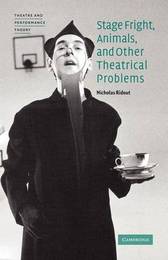
|
Stage Fright, Animals, and Other Theatrical Problems
Paperback / softback
Main Details
| Title |
Stage Fright, Animals, and Other Theatrical Problems
|
| Authors and Contributors |
By (author) Nicholas Ridout
|
| Series | Theatre and Performance Theory |
|---|
| Physical Properties |
| Format:Paperback / softback | | Pages:206 | | Dimensions(mm): Height 216,Width 140 |
|
| Category/Genre | Drama |
|---|
| ISBN/Barcode |
9780521617567
|
| Classifications | Dewey:792 |
|---|
| Audience | | Professional & Vocational | | Tertiary Education (US: College) | |
|---|
| Illustrations |
Worked examples or Exercises
|
|
Publishing Details |
| Publisher |
Cambridge University Press
|
| Imprint |
Cambridge University Press
|
| Publication Date |
17 August 2006 |
| Publication Country |
United Kingdom
|
Description
Why do actors get stage fright? What is so embarrassing about joining in? Why not work with animals and children, and why is it so hard not to collapse into helpless laughter when things go wrong? In trying to answer these questions - usually ignored by theatre scholarship but of enduring interest to theatre professionals and audiences alike - Nicholas Ridout attempts to explain the relationship between these apparently unwanted and anomalous phenomena and the wider social and political meanings of the modern theatre. This book focuses on the theatrical encounter - those events in which actor and audience come face to face in a strangely compromised and alienated intimacy - arguing that the modern theatre has become a place where we entertain ourselves by experimenting with our feelings about work, social relations and about feelings themselves.
Author Biography
Nicholas Ridout is Lecturer in Performance at the School of English and Drama, Queen Mary, University of London.
Reviews'... an intelligent and likeable study that merely attempts a virtually holistic understanding of theatre in its fullest possible contest.' Times Literary Supplement 'In the intellectual energy of the connections it makes, and in the purposeful play of its attentive unfolding of the insistently overlooked and repressed within theatre, this volume makes a significant contribution to a growing body of recent and related British scholarship.' Contemporary Theatre Review
|